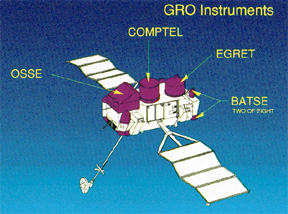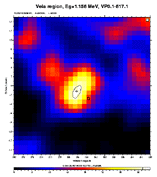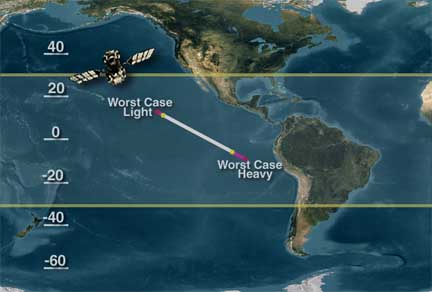Imagine the Universe! News Desk
Compton Gamma Ray Observatory to be Retired
NASA Plans Controlled Re-entry into Earth's Atmosphere
After Nine Years of Successful Gamma Ray Astronomy
| 27 March 2000 |
 The Compton Gamma Ray Observatory (GRO) carries a collection of four instruments: the Burst And Transient Source Experiment (BATSE), the Oriented Scintillation Spectrometer Experiment (OSSE), the Imaging Compton Telescope (COMPTEL), and the Energetic Gamma Ray Experiment Telescope (EGRET). |
NASA's extremely productive and long-lived Compton Gamma-Ray Observatory (CGRO) will end its mission in late May as it is brought back to Earth under a controlled re-entry plan. In December 1999 CGRO suffered the loss of one of it's three gyroscopes which are used to control the orientation of the satellite. NASA decided that the safest course of action was to bring the satellite down using the two remaining gyros. CGRO exceeded its expected mission lifetime by four years and completely changed ideas on the most important unsolved puzzles in astrophysics.
NASA plans to safely direct the satellite back into Earth's atmosphere starting with the first of 4 burns by the satellite's small thrusters on May 26. As an extra precaution, Compton engineers are also developing a backup method to control the satellite in case either or both of the remaining gyroscopes fail during the reentry maneuvers. Compton's four instruments are still in working order, and will continue to make observations of celestial gamma-ray sources until May 26.
"NASA must have a controlled reentry to direct Compton towards an uninhabited area in the Pacific ocean, " said Dr. Ed Weiler, Associate Administrator for the Office of Space Science, NASA Headquarters. "NASA decided before Compton was launched that, due to its size, it would be returned to Earth by controlled reentry when the mission was over. This was always NASA's plan. "
 A COMPTEL gamma-ray image of a nearby supernova remnant |
"Compton has been a workhorse for nine years, far exceeding our expectations for a two- to five-year mission," said Dr. Alan Bunner, director of NASA's Structure and Evolution of the Universe science theme, NASA Headquarters, Washington, DC. "New discoveries made by Compton changed our view of the Universe in fundamental ways."
Compton's lasting legacy will be its impact on gamma ray astronomy. The telescope detected more than 400 gamma ray sources, 10 times more than were previously known. Compton recorded more than 2,500 gamma ray bursts; before Compton, only about 300 had been detected.
The propulsion system on Compton lacks sufficient fuel to boost the spacecraft to a higher, longer-lived orbit. Left alone, Compton will eventually fall from orbit due to a minute drag from the Earth's tenuous atmosphere at Compton's orbital height. Unlike most other satellites, Compton is too large to burn up entirely in the atmosphere during reentry. An uncontrolled reentry would expose some area under its orbital path (between 28.5 degrees north and south latitude) to the risk of falling debris.
The decision to reenter Compton before a second gyroscope fails, even though the satellite is functioning normally, was made at NASA Headquarters on March 23, 2000, after extensive study to consider all options. CGRO was not designed to be serviced by the Space Shuttle, and the time to prepare for servicing by the Shuttle and the risks involved were deemed too high. Research showed it was significantly safer to perform a controlled reentry than any other method of dealing with the satellite. "We actively pursued the option that provided the lowest risk to human lives," said Weiler.
Debris from the reentry will be scattered over an area estimated to be 16 miles wide and 962 miles long. The center of the reentry area is on the equator approximately 2,500 miles southeast of Hawaii (about 120 degrees west longitude). A large portion of the satellite will vaporize as it transits the atmosphere, and most of the pieces that survive will be tiny, about the size of a pea or a grain of sand. However, Compton contains structures made of titanium, which are expected to fall as larger pieces.

The projected reentry path of CGRO. Debris from the disintegrating spacecraft will fall in this area.
"Enough will survive to present a small but still unacceptable risk to populated areas if Compton were allowed to reenter in an uncontrolled manner," said Preston Burch, Deputy Program Manager for Space Science Operations at NASA's Goddard Space Flight Center, Greenbelt, MD. "NASA will work closely with aviation and maritime authorities to ensure the impact area is free from traffic during reentry."
Compton flight controllers, stationed at Goddard, will fire Compton's propulsion system thrusters in the direction opposite to its orbital motion, which will slow the spacecraft down and cause its orbital height to decrease so that it reenters the atmosphere. There will be four separate firings of the propulsion system thrusters, each about a day apart. After each firing, Compton's new orbit will be determined precisely, and the performance of the thrusters will be evaluated. The thruster performance varies according to the pressure of the propellant, so the thrusters will not perform the same way because each firing consumes propellant, which decreases its pressure.
NASA and international space agencies plan several upcoming missions to continue where Compton left off, including SWIFT and GLAST. The Compton Gamma Ray Observatory was the second of NASA's Great Observatories and the gamma-ray equivalent to the Hubble Space Telescope and the Chandra X-ray Observatory. Compton was launched aboard the Space Shuttle Atlantis in April 1991, and, at 17 tons, was the largest astrophysical payload ever flown at that time.
[NOTE: Swift launched on November 20, 2004 and GLAST launched on June 11, 2008.]

